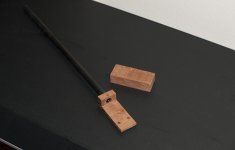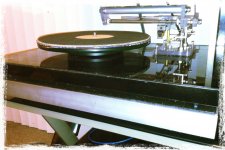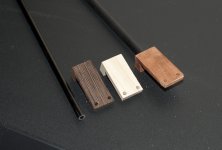Paul,
Graphite | Metals | Salomon's Metalen
carbon staaf - Carbonwinkel.nl
Webshop | de Wolfabriek voor breien, haken, wol en patronen (I ordered here 6mm in the past.)
Hans.
Thanks Hans !! very practical info !!
I'll get in touch with them later today .
THX
Paul
A hint to all building,
Try and make the tail of the wand longer so that you can use a smaller counterweight thus lowering horizontal mass while increasing vertical mass. I use a 6" wand it should be set so that for the specific cartridge the counterweight is almost at the end of the tail, this will mean different weights for different cartridges, I've offered as much useful information as possible here so it's up to you folks now 🙂.
Colin
THX Collin ! time to figure ourselfs indeed 😱
Many approaches throughout the thread , so much to figure in the near future .
THX again for all the usefull info so far , you are a rock 😀
Paul
I think it's not so easy to measure a force this small .. however , I think in practice one could use a small PC fan to create a side force ( air flow ) just to figure between different approaches . I'n not into physics , but using some common sense should tell is what's going on .
I think 😛
Paul
You can push the diamond with the very soft brush you use to clean it.
If the carriage moves you don't have the risk to damage the stylus.
how can you compare the friction of an air bearing and a mechanical bearing? Best regards Moray James.
Nothing was mentioned about friction.. spinning wheel was trying to reduce weight and the comment and comparison? 🙂
Regards
David
Nothing was mentioned about friction.. spinning wheel was trying to reduce weight and the comment and comparison? 🙂
Regards
David
I am not sure that I understand your comment. reduction of mass is important with either type of bearing. an air bearing will have a distinct advantage in terms of friction over a mechanical bearing. perhaps I am not understanding if so I apologize. please explain if you would. thank you. best regards Moray James.
This also looks very promising
PTFE Rod (qty 2 x 300mm lengths) 6, 8, 10 or12mm diam | eBay
Although I do not know how much stiffness counts. But I bet we cannot beat teflon for friction.
PTFE Rod (qty 2 x 300mm lengths) 6, 8, 10 or12mm diam | eBay
Although I do not know how much stiffness counts. But I bet we cannot beat teflon for friction.
With Teflon you don't need bearings at all.
Because it is not sure ball bearings will roll.
Dirt sticks to teflon with the greatest of ease. You will get plenty of friction.
progress
I ordered some carbon tube yesterday . 5 and 6 MM tubes , 0.65 MM wall
Carbon buizen
My current carriage weighs 22 Gram .. w/o cart and counterweight .
Wanna loose some more weight by using a thin carbon tube instead of the current alu tube .
What about drilling many holes in alu tube to control weight ?
Paul
I ordered some carbon tube yesterday . 5 and 6 MM tubes , 0.65 MM wall
Carbon buizen
My current carriage weighs 22 Gram .. w/o cart and counterweight .
Wanna loose some more weight by using a thin carbon tube instead of the current alu tube .
What about drilling many holes in alu tube to control weight ?
Paul
Don,t feel too bad, the Kuzma air tone arm has a horizontal mass of 80 grams!
I'll keep the heavy carriage of course 😉 and will use it as soon as my arm construct is up and working .
Comments will follow than too

Paul
As long as you keep the carriage and cartridge under 30g total you will be good to go. The requirements are different depending on which plane you put the counterweight.
C
C
As long as you keep the carriage and cartridge under 30g total you will be good to go. The requirements are different depending on which plane you put the counterweight.
C
C
I finally started working on my version. Working on the headshell-tonearm for now.
I bought two carbon arrows from a local shop for 12 euros. They are about 50cm usable tube each, so much room for error and trial.
These ones are 7.5mm in diameter. A bit on the thick side, but still thinner than what would fit in my aluminum Jelco head-shell which I was planning to use.
So I decided to make my own head-shell. I wanted to make one out of maple but I had no scraps, so I instead made one out of mahogany. It s pretty nice and light, but I think I would have liked maple more. Meh... I made it in about 10minutes, so I guess it won t be a problem to try maple or wenge as well. Although they will be quite heavier.
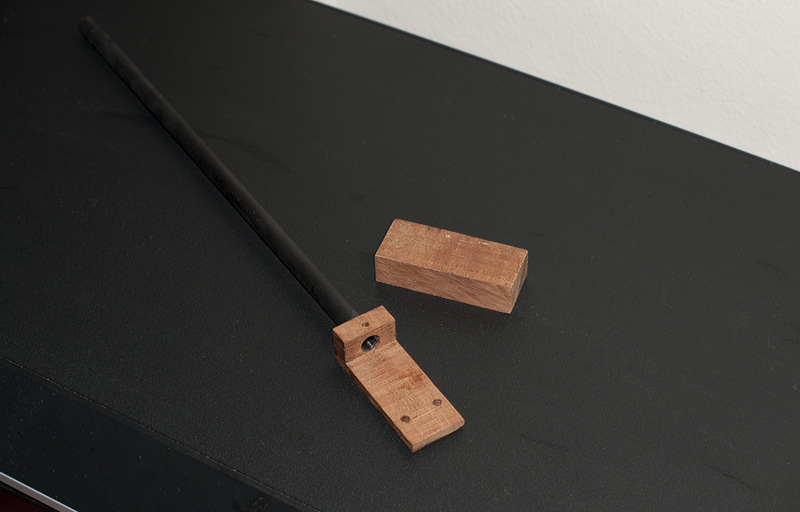
The arm tube is 22cm for now and the entire thing weighs 5grams exactly. I guess the final arm will be shorter. Oh and I m sure I can afford to make the head-shell shorter too. I used the Jelco as a template, but I don t think I need the rail for the screws or its length for this application. I guess I could get rid of a couple of grams this way too.
I bought two carbon arrows from a local shop for 12 euros. They are about 50cm usable tube each, so much room for error and trial.
These ones are 7.5mm in diameter. A bit on the thick side, but still thinner than what would fit in my aluminum Jelco head-shell which I was planning to use.
So I decided to make my own head-shell. I wanted to make one out of maple but I had no scraps, so I instead made one out of mahogany. It s pretty nice and light, but I think I would have liked maple more. Meh... I made it in about 10minutes, so I guess it won t be a problem to try maple or wenge as well. Although they will be quite heavier.
The arm tube is 22cm for now and the entire thing weighs 5grams exactly. I guess the final arm will be shorter. Oh and I m sure I can afford to make the head-shell shorter too. I used the Jelco as a template, but I don t think I need the rail for the screws or its length for this application. I guess I could get rid of a couple of grams this way too.
Attachments
Colin:
You did a very nice job on that arm !!! What is the distance between the bottom of the glass tube and the top of the platter ?
Joe
You did a very nice job on that arm !!! What is the distance between the bottom of the glass tube and the top of the platter ?
Joe
The whole completed beast, between the arm and table, and no it doesn't cut vinyl 🙂.
Colin
What a great mean machine you have created there , Collin 😱
I just got back from the shop . picking up some polycarbonate sheets .. 6 and 8 MM thick . must be a pleasant material to work with .
Paul
My thinner tube is heavier after all... Because of the thicker material. 1mm thick and 3.4gr the one and 0,35mm and 2,8gr for the other one. So I am keeping the 7.5mm tube since it is lighter but does not lose anything in stiffness.
I have also tried maple and wenge for the head-shell. Mahagony is way ligther from both of them. The 3 head-shells I made are not that different in size, but the weight is significantly different. Almost double.
Now I just have to create a template to be able to make them with more accuracy. I also like Colin's design. The shell is much smaller. Perhaps I m going to try that as well. I just would have liked more area to touch the cartridge.
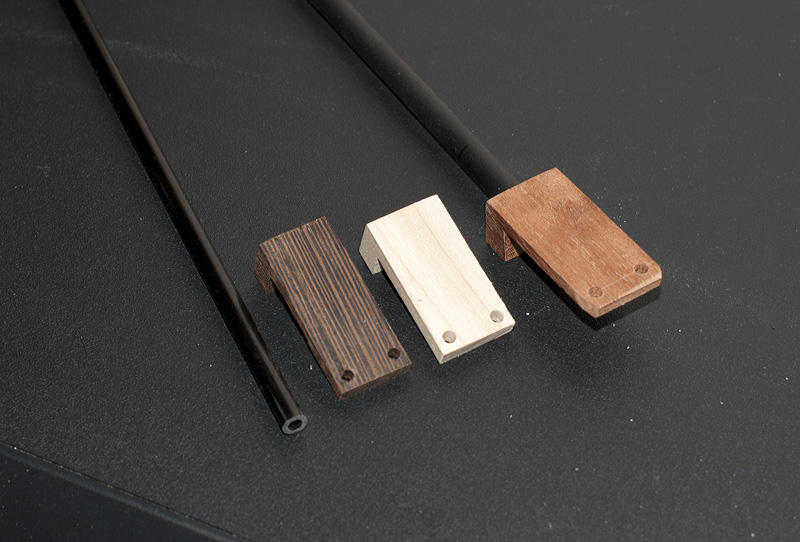
I have also tried maple and wenge for the head-shell. Mahagony is way ligther from both of them. The 3 head-shells I made are not that different in size, but the weight is significantly different. Almost double.
Now I just have to create a template to be able to make them with more accuracy. I also like Colin's design. The shell is much smaller. Perhaps I m going to try that as well. I just would have liked more area to touch the cartridge.
Attachments
I made a salas phono and a nelson b1 buffer and I have got to say I cannot believe it is possible to get audio like this from vinyl.
Colin: What is the distance between the bottom of the glass tube and the top of the platter ?Joe
Almost thought I'd explain it but, no. It's already been done.
- Home
- Source & Line
- Analogue Source
- DIY linear tonearm
